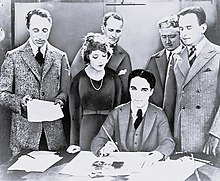United Artists was incorporated as a joint venture on February 5, 1919, by four of the leading figures in early Hollywood: Mary Pickford, Charlie Chaplin, Douglas Fairbanks, and D. W. Griffith. Each held a 20% stake, with the remaining 20% held by lawyer William Gibbs McAdoo.[4] The idea for the venture originated with Fairbanks, Chaplin, Pickford, and cowboy star William S. Hart a year earlier as they were traveling around the U.S. selling Liberty bonds to help the World War I effort. Already veterans of Hollywood, the four film stars began to talk of forming their own company to better control their own work as well as their futures.
They were spurred on by established Hollywood producers and distributors who were tightening their control over actor salaries and creative decisions, a process that evolved into the rigid studio system. With the addition of Griffith, planning began, but Hart bowed out before things had formalized. When he heard about their scheme, Richard A. Rowland, head of Metro Pictures, is said to have observed, "The inmates are taking over the asylum." The four partners, with advice from McAdoo (son-in-law and former Treasury Secretary of then-President Woodrow Wilson), formed their distribution company, with Hiram Abrams as its first managing director.
The original terms called for Pickford, Fairbanks, Griffith and Chaplin to independently produce five pictures each year. But by the time the company got under way in 1920–1921, feature films were becoming more expensive and more polished, and running times had settled at around ninety minutes (or eight reels). It was believed that no one, no matter how popular, could produce and star in five quality feature films a year. By 1924, by which time Griffith had dropped out, the company was facing a crisis: either bring in others to help support a costly distribution system or concede defeat. The veteran producer Joseph Schenck was hired as president. Not only had he been producing pictures for a decade, but he brought along commitments for films starring his wife, Norma Talmadge, his sister-in-law, Constance Talmadge, and his brother-in-law, Buster Keaton. Contracts were signed with a number of independent producers, most notably Samuel Goldwyn, Alexander Korda and Howard Hughes. Schenck also formed a separate partnership with Pickford and Chaplin to buy and build theaters under the United Artists name. They also began international operations, first in Canada, then in Mexico, and by the end of the 1930s, United Artists was represented in over 40 countries.
Still, even with a broadening of the company, UA struggled. The coming of sound ended the careers of Pickford and Fairbanks. Chaplin, rich enough to do what he pleased, worked only occasionally. Schenck resigned in 1933 to organize a new company with Darryl F. Zanuck, Twentieth Century Pictures, which soon provided four pictures a year to UA's schedule. He was replaced as president by sales manager Al Lichtman who himself resigned after only a few months. Pickford produced a few films, and at various times Goldwyn, Korda, Walt Disney, Walter Wanger, and David O. Selznick were made "producing partners" (i.e., sharing in the profits), but ownership still rested with the founders. As the years passed and the dynamics of the business changed, these "producing partners" drifted away, Goldwyn and Disney to RKO, Wanger toUniversal Pictures, Selznick to retirement. By the late 1940s, United Artists had virtually ceased to exist as either a producer or distributor. It sold off its Mexican releasing division to Crédito Cinematográfico Mexicano, a local company.
Charlie Chaplin seated with Mary Picford, Douglas Fairbanks and D.W. Griffith. These were the most power and richest stars of the Silent Era. Also seated below. D.W. Griffith produced Birth of a Nation.The Tom Cruise era
On November 2, 2006, MGM announced that actor Tom Cruise and his long-time production partner Paula Wagner were resurrecting UA[15][16] (this announcement came after the duo were released from a fourteen-year production relationship at Viacom-owned Paramount Pictures earlier that year). Cruise, Wagner and MGM Studios created United Artists Entertainment LLC and the producer/actor and his partner owned a 30% stake in the studio,[17] with the approval by MGM's consortium of owners.
The deal gave them control over production and development of films. Wagner was named CEO of United Artists, which was allotted an annual slate of four films with different budget ranges, while Cruise served as a producer for the revamped studio as well as serving as the occasional star.
UA became the first motion picture studio granted a WGA waiver in January 2008 during the Writers' Strike.[18]
On August 14, 2008, MGM announced Paula Wagner would leave United Artists to produce films independently.[2] Her output as head of UA was two films, both starring Cruise, Lions for Lambs[19] and Valkyrie, the latter of which, despite mixed reviews, was successful at the box office thanks to $117 million in foreign revenue.[20] Wagner's departure led to speculation that an overhaul at United Artists was imminent.[2]
Since then, United Artists has merely served as a co-producer with MGM for two releases: the 2009 remake of Fame and Hot Tub Time Machine. Throughout 2010, continued debt and credit issues for MGM Holdings, Inc., United Artists' parent company had left the future of MGM and UA in doubt until it was resolved near the end of the year.
A 2011 financial report revealed that MGM reacquired its 100% stake in United Artists.[17] MGM might continue to make new films under the UA brand.[17]







No comments:
Post a Comment
Please comment on what you see and read here. Tell me what you like, dislike or want to know about these three men.